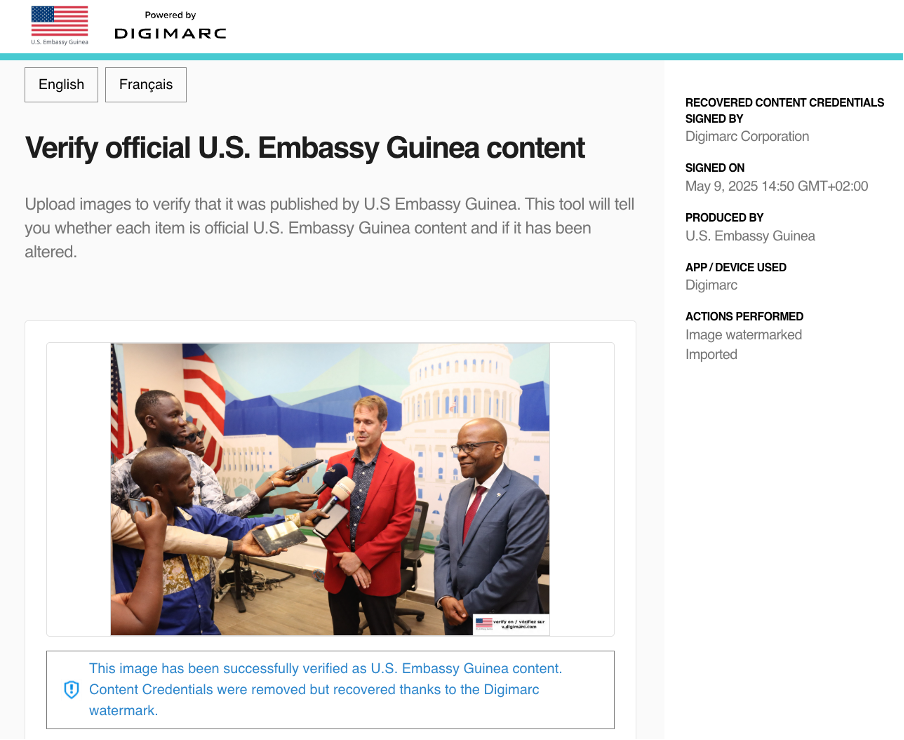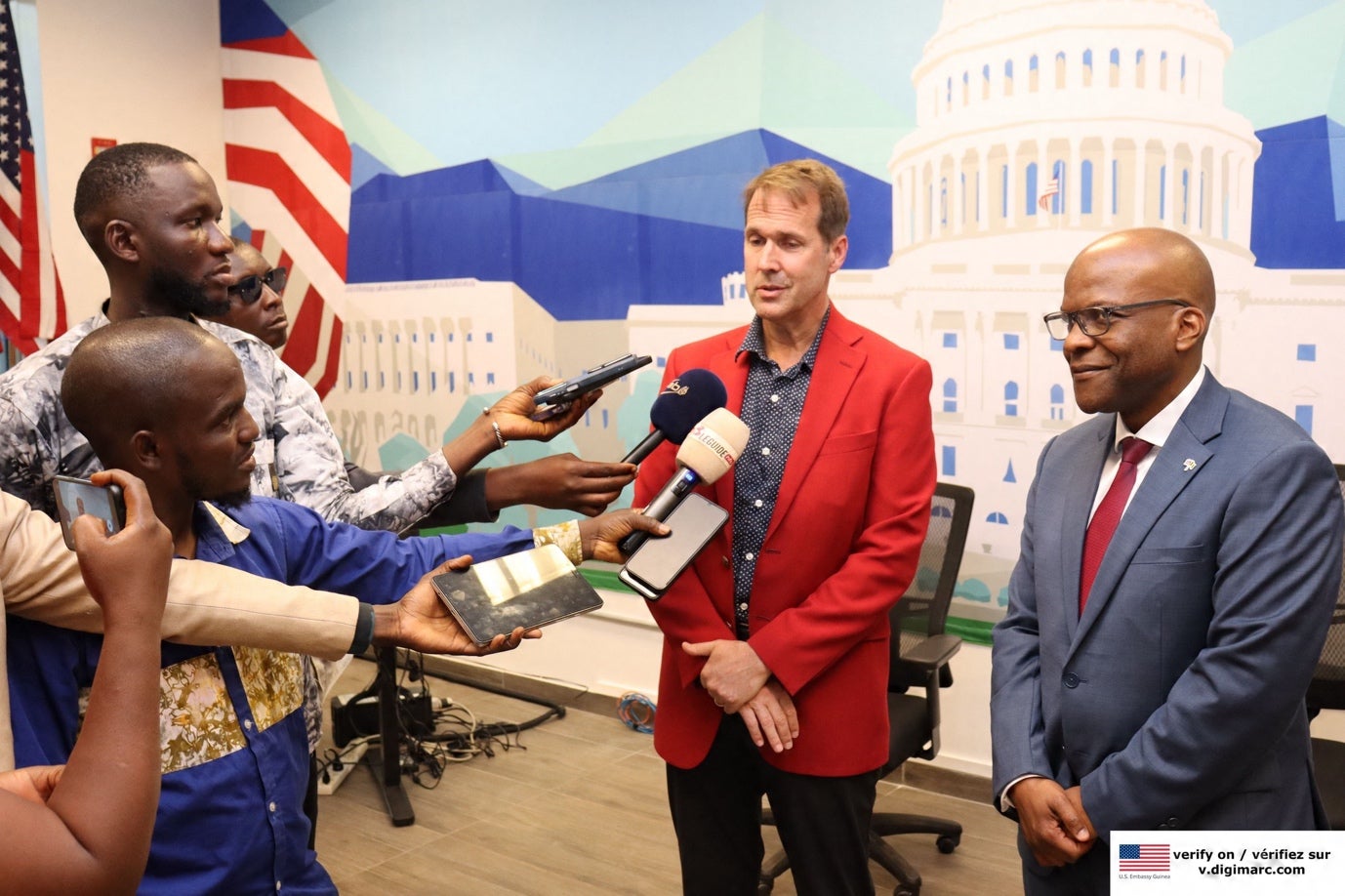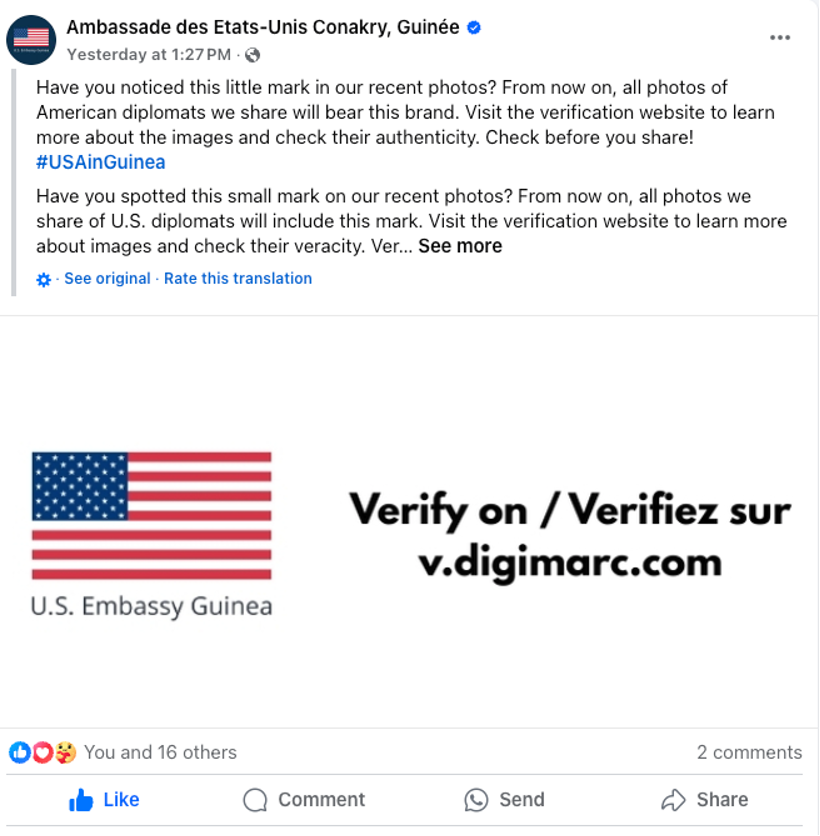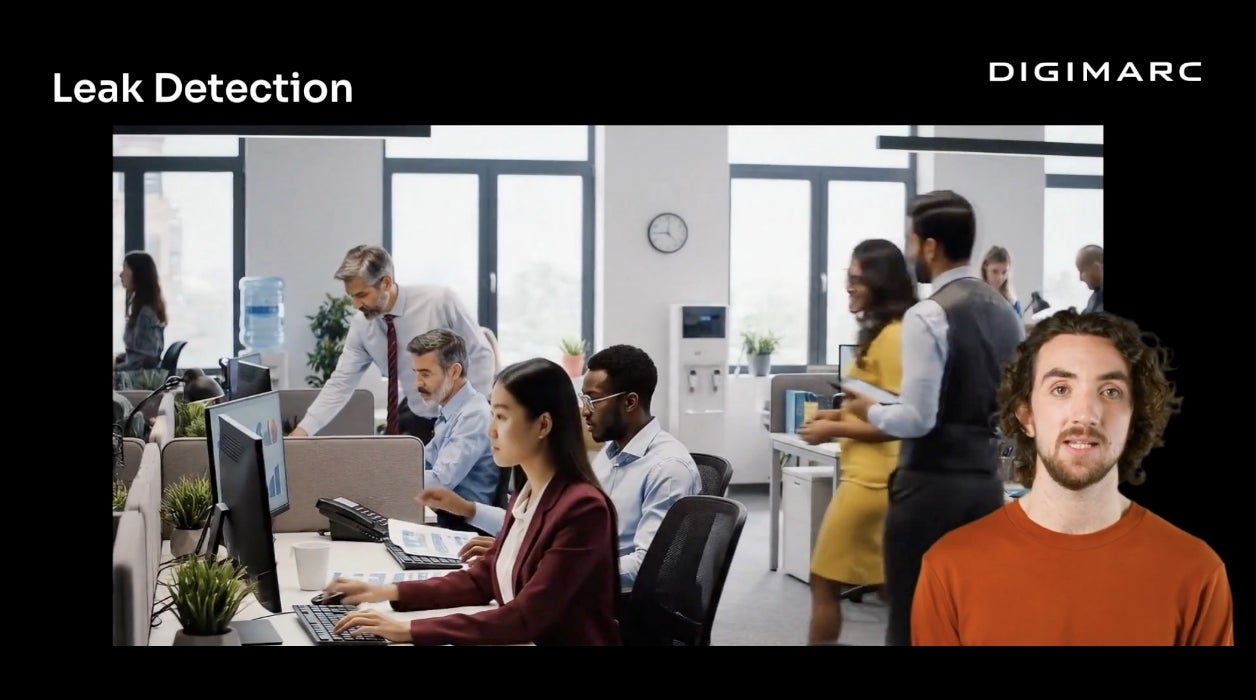In an era where misinformation and deepfakes are eroding public trust, the U.S. Embassy in Conakry is taking bold steps to protect the integrity of its communications. By launching a digital content verification initiative, the Embassy is empowering Guineans to assess the authenticity of images shared online — a vital tool in a country where many citizens are newly connected and increasingly vulnerable to manipulated media. At the heart of this initiative is a secure image verification system powered by Digimarc’s digital watermarking technology and global standards known as Content Credentials (C2PA). Together, these technologies allow anyone to verify whether an image is authentic, when it was created, and whether it’s been edited — even if the original metadata has been stripped away.

The digital content verification platform powered by Digimarc, allowing Guineans to check if an asset was indeed published by the U.S. Embassy in Conakry and get detailed content provenance information.
In early 2025, deepfake videos circulated online falsely depicting the French Ambassador and Guinean political leaders in compromising situations. Another viral video falsely claimed that U.S. forces were training Guinean security forces to attack civilians. While no manipulated images from the Embassy have been detected to date, the U.S. Embassy Conakry recognized the need to proactively secure its communications and reinforce public trust.
In Guinea, the digital revolution is transforming lives — but not without risk. As Internet access spreads rapidly, especially among young people, an entire generation is coming online without the tools to tell fact from fiction. For many, platforms like Facebook are the primary source of news and information. But with this access comes exposure to deepfakes, conspiracy theories, and false narratives that can shape perceptions and destabilize trust in institutions. The risk is also exacerbated by the fast development and widespread availability of Generative AI (GenAI) technologies.
That’s why this initiative matters. It’s not just about technology — it’s about equipping a rising digital generation with the power to question what they see, understand where it came from, and make informed decisions in an increasingly noisy information landscape.

The provenance and authenticity of this U.S. Embassy Conakry picture are verifiable thanks to the imperceptible digital watermark it contains, linking to C2PA Content Credentials.
At the end of April 2025, the U.S. Embassy Conakry began embedding Digimarc digital watermarks and C2PA Content Credentials into all Embassy images of U.S. officers shared on social media. C2PA Content Credentials are a standards-based technology designed to address the issue of trust by tracking the origin and history of digital assets—like nutritional facts for digital content. They help answer key questions such as: How was it made? Who created it? Was it AI-generated? When was it created? How was it edited?
The imperceptible watermark links to the associated Content Credentials, enabling users to confirm that the content originated from the U.S. Embassy and has not been altered. Additionally, the Content Credentials provide detailed provenance information, including any modifications made to the image and whether GenAI tools were used in its creation or editing.
To enhance visibility, the protected images also feature a superimposed Embassy logo and the address of the verification website, directing users to the platform where they can verify the content’s authenticity.

U.S. Embassy Conakry “Verify before you share” campaign on Facebook guiding users to verify content provenance before sharing it further
The Embassy launched the accompanying Verifier Avant de Partager (Verify Before You Share) campaign through a press release and social media posts. The campaign explains the image verification process to Guinean audiences as a transparency tool that empowers users to judge content for themselves. The messages encourage followers to question the authenticity of images, identify sources, and critically evaluate online content.

The three pillars of durable Content Credentials: Verifiable Digital Signatures, C2PA manifests and now, Digital Watermarks.
This implementation is a great example of the power of combining digital watermarks with C2PA Content Credentials. Indeed, Content Credentials are added as metadata to an asset, rather than being embedded into the asset itself. As a result, the metadata can easily be stripped from a digital asset. For instance, posting on most social networks or editing an asset is likely to remove the Content Credentials, detaching the asset from its provenance information.
This was a significant issue for the U.S. Embassy in Conakry, as Facebook is one of the most significant communication channels in Guinea. Therefore, using Content Credentials alone would have led to the loss of provenance information in most cases, as Facebook systematically removes this metadata.
Luckily, in 2023, I had the chance to co-chair the C2PA watermarking task force alongside Adobe. The C2PA watermarking task force was given the mission to make Content Credentials more durable through the integration of digital watermarking technologies. Digital watermarks create a more persistent link between an asset and its manifest. An imperceptible digital watermark embedded in an image, video, or audio track references the Content Credentials and helps recover them should they become detached. The recent release of C2PA 2.2 brings the efforts of this task force to the public. Thanks to digital watermarks, Content Credentials can now be made more durable. Thanks to digital watermarks, Content Credentials can now be made more durable.
In Guinea, just like in the rest of the world, the rise of generative artificial intelligence (GenAI)—both in capability and accessibility—has resulted in a heightened risk of media manipulation. Content consumers are wondering what can and cannot be trusted online. Re-establishing trust in digital content in the age of GenAI is a very timely topic.
With this campaign, the U.S. Embassy in Conakry continues to pioneer responsible public diplomacy technologies that build public confidence in Embassy messaging. By embedding standards-based verification into their media workflow and encouraging audiences to question digital content, they have taken a preventive step to protect the Embassy’s credibility.
The success of this initiative in Guinea is just the beginning. As misinformation and AI-generated content continue to spread globally, embassies, government agencies, media organizations, and NGOs all face a common challenge: how to protect public trust in the digital age?
By embedding content transparency and verification into their communications, these institutions can lead by example — strengthening credibility, promoting media literacy, and ensuring their messages reach communities with clarity and confidence.
If you're looking to reinforce your organization’s digital integrity or explore how this approach could support your mission, we’d love to connect. Let’s work together to scale this impact.
